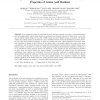Free Online Productivity Tools
i2Speak
i2Symbol
i2OCR
iTex2Img
iWeb2Print
iWeb2Shot
i2Type
iPdf2Split
iPdf2Merge
i2Bopomofo
i2Arabic
i2Style
i2Image
i2PDF
iLatex2Rtf
Sci2ools
JCC
2007
2007
Peptide reagent design based on physical and chemical properties of amino acid residues
: It has tremendous values for both drug discovery and basic research to develop a solid bioinformatical tool for guiding peptide reagent design. Based on the physical and chemical properties of amino acids, a new strategy for peptide reagent design, the so-called AABPD (amino acid based-peptide design), is proposed. The peptide samples in a training dataset are described by a series of HMLP (heuristic molecular lipophilicity potential) parameters and other physicochemical properties of amino acid residues that form a three-dimensional data matrix where each component is defined by three indexes: the first index refers to the peptide samples, the second to the amino acid positions, and the third to the amino acid parameters. The binding free energy between a peptide ligand and its protein receptor is calculated by a linear free energy equation through the physicochemical parameters, resulting in a set of simultaneous linear equations between the bioactivity of the peptides and the ph...
| Added | 15 Dec 2010 |
| Updated | 15 Dec 2010 |
| Type | Journal |
| Year | 2007 |
| Where | JCC |
| Authors | Qishi Du, Ri-Bo Huang, Yu-Tuo Wei, Cheng-Hua Wang, Kuo-Chen Chou |
Comments (0)

